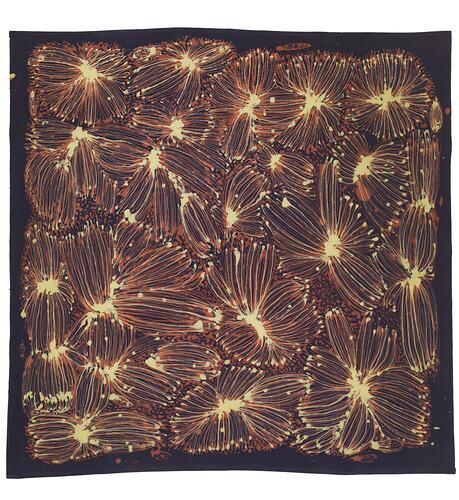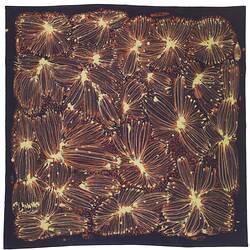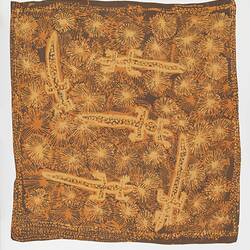In 1977 a group of Alyawarr and Anmatyerr Aboriginal women from the Utopia region in the Northern Territory were taught the techniques for making batik fabric in a series of government sponsored workshops facilitated by Jenny Green. The following year the Utopia Women's Batik Group was formed with Julia Murray becoming art coordinator for the next five years. Some of the original members of the group include: Emily Kngwarreye, Audrey Kngwarreye, Lena Pwerle, Rosy Kunoth Kngwarreye, and the Petyarre Sisters: Kathleen, Violet, Gloria, Nancy, Myrtle and Ada. Many of these women later became significant figures in both the Australian and international art scenes.
Batik is a method of decorating cloth by applying hot wax to the surface of the fabric as a resistance to dyes. The process is repeated several times, depending on the intricacy of the design and number of colours. The wax is finally removed in boiling water.
The money raised through the sale of their early batiks assisted with the successful claim for Alyawarr and Anmatyerr freehold title over the Utopia Pastoral Lease in 1979. In addition to providing a source of income and demonstrating the economic viability of the outstations; the batiks were also used in conjunction with ceremony, as evidence of the women's ownership of country, during the land claim hearings.
Museum Victoria was the first cultural institution in Australia to collect Utopia batiks from this foundational period. With those acquired in 1979 including two by the internationally acclaimed artist, the late Emily Kngwarreye.
During the 1980s awareness of the Utopia Women's Batik Group artwork began to grow. In 1981 they exhibited 'Floating Forests of Silk: Utopia Batik from the Desert' at the Adelaide Art Festival. In 1987 Rodney Gooch of the Central Australian Aboriginal Media Association (CAAMA) became art coordinator and he began looking for ways to expand the promotion and diversification of art at Utopia. In 1988 the group were commissioned to produce the opening exhibition for the Tandanya Aboriginal Cultural Institute in Adelaide. Consisting of 88 batiks and titled 'Utopia - A Picture Story' the exhibition toured internationally before the works were purchased by the Holmes à Court Collection in Perth.
In 1988-1989 CAAMA in conjunction with the Holmes à Court Collection began a project to introduce the Utopia Women's Batik Group to painting on canvas with acrylic paints. The resulting exhibition 'A Summer Project' consisted of 82 canvases which were intended to help increase the sale price of the Utopia women's work shifting it from 'craft' to 'fine art'. The skills learned by the Utopia artists in the batik making process gave them a distinctive approach to painting, incorporating techniques such as layering and fine line making.
A key component of the work of the Utopia artists, both in their batiks and paintings, is the connection to country. The Utopia women are empowered to paint specific Dreamings as a matter of heredity, as they began producing artwork the women of Utopia moved this imagery and knowledge from sand and body painting to silk and canvas. Stories from the Dreaming as well as an individual connections to their land and the dry but occasionally lush landscape have been key themes in their work.
In 1991 CAAMA ceased its managing and support role, and since then the artists of Utopia have mainly made their own arrangements to sell their work through a network of dealers and representatives. There is no community owned or controlled art centre in the way that there is in many other central and northern Australian communities. In spite of this members of the original Utopia Women's Batik Group have been active in transmitting their knowledge and skills to the younger generation, with their daughters, nieces, grandnieces and granddaughters continuing to produce art.
In 2007 Julia Murray returned to Utopia to conduct the Utopia Batik Revival Workshop over a period of three months. The workshop included both members of the original group as well as those who were new to the medium. Museum Victoria acquired four batiks from this project by Audrey Kngwarreye, Lena Pwerle, Myrtle Petyarre and Rosie Kunoth Kngwarreye, who were all members of the original Utopia Women's Batik Group.
References
Bell, Diane, 2002, 'Person and place: Making meaning of the art of Australian indigenous women', Feminist Studies, Vol 28, No 1, pp.95-127.
Koch, Grace, 2013, We have the song, so we have the land: song and ceremony as proof of ownership in Aboriginal and Torres Strait Islander land claims, AIATSIS research discussion paper no. 33, AIATSIS Research Publications, Canberra.
McCulloch, Susan, 1999, Contemporary aboriginal art: a guide to the rebirth of an ancient culture, Allen & Unwin, St Leonards, N.S.W. pp.81-90
Nicholls, Christine, 1999, 'An introduction to the women painters of Utopia, Northern Territory', Journal of the Anthropological Society of South Australia, Vol. 32, No 1-2, pp. 1-27.
Schmidt, Chrischona, 2011, 'Rodney Gooch's Role and Influence in the Development of the Utopia Art Movement: A History of the Art Movement and Rodney Gooch's Role within it', The International Journal of the Arts in Society, Vol 5, No 6, pp.149-162
More Information
-
Keywords
-
Authors
-
Article types


